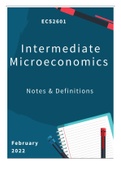, PRESCRIBED BOOK:
Microeconomics 9th edition - RS. Pindyck & DL. Rubinfeld (2017)
REFERENCE PAGES:
(Please note that the indicated study and omission pages in the study guide refers to the
previous textbook: Microeconomics for UNISA Pindyck RS. & Rubinfeld DL. (2009) and
should be ignored if you are using the 2017 version: Microeconomics 9th edition
RS. Pindyck & DL. Rubinfeld.
Learning Unit 1: Introduction
Learning Unit 2: Elasticity
• Omit page 43 – 54
• Study page 55 -70
• Omit page 71-79
• Study page 80 – 83
Learning Unit 3: Consumer Behaviour
• Study page 91 – 102
• Study page 104 - 114
• Omit page 114 – 117 and Example 3.6
• Study page 117 – 122 and Example 3.7
• Omit page 122 – 126
Learning Unit 4: Individual & Market Demand
• Study page 132 -142
• Study page 144 – 148 and Example 4.3
• Study page 152 – 158 and Example 4.6
• Omit page 159 - 163
Omit Learning Unit 5
Learning Unit 6: Production
• Study page 209 – 233
Learning Unit 7: The Cost of Production
• Study page 237 – 248
• Omit Example 7.1
• Study page 245 – 268 and Example 7.3
• Omit page 269 “The degrees of economies of scope”
• Omit page 270 – 278
ECS2601 February 2022 Page 2
, ASSIGNMENT 01 DUE:
Friday, 4 March 2022, 21:00
Complete and submit compulsory Assignment 01.
Assignment 01 is based on learning units 1–7.
LEARNING UNIT 1:
ASSUMPTIONS OF PRIOR LEARNING IN MICROECONOMICS
Definition of Microeconomics
Microeconomics deals with the behaviour of individual economic units. These units
include consumers, workers, investors, owners of land, business firms—in fact, any
individual or entity that plays a role in the functioning of our economy and explains how
and why these units make economic decisions.
Positive analysis: Statements that describe relationships of cause and effect.
Normative analysis: Analysis examining questions of what ought to be.
Market: The collection of buyers and sellers that, through their actual or
potential interactions, determine the price of a product or set of
products.
Market definition: Determination of the buyers, sellers, and range of products that
should be included in a particular market.
Arbitrage: Practice of buying at a low price at one location and selling at a
higher price in another.
Industry: A collection of firms that sell the same or closely related
products. In effect, an industry is the supply side of the market.
Perfectly competitive market: Market with many buyers and sellers, so that no
single buyer or seller has a significant impact on price.
Market price: Price prevailing in a competitive market.
Extent of a market: Boundaries of a market, both geographical and in terms of
range of products produced and sold within it.
Nominal price: Absolute price of a good, unadjusted for inflation.
Real price: Price of a good relative to an aggregate measure of prices;
price adjusted for inflation.
Consumer Price Index: Measure of the aggregate price level.
ECS2601 February 2022 Page 3
,Producer Price Index: Measure of the aggregate price level for intermediate products
and wholesale goods.
LEARNING UNIT 2:
ELASTICITY
Supply curve:
The supply curve is the relationship between the quantity supplied and the price. We can
write this relationship as an equation: QS = QS(P)
To distinguish between the two graphical depictions of supply changes, economists often
use the phrase change in supply to refer to shifts in the supply curve, while reserving the
phrase change in the quantity supplied to apply to movements along the supply curve.
Demand curve:
The demand curve shows how much of a good consumers are willing to buy as the price
per unit changes. We can write this relationship between quantity demanded and price
as an equation: QD = QD(P)
Supply & Demand:
ECS2601 February 2022 Page 4
, Substitutes: Two goods for which an increase in the price of one leads to an
increase in the quantity demanded of the other.
Complements: Two goods for which an increase in the price of one leads to a
decrease in the quantity demanded of the other.
Equilibrium price: Price that equates the quantity supplied to the quantity demanded.
At this point, because there is neither excess demand nor excess
supply, there is no pressure for the price to change.
Market mechanism: Tendency in a free market for price to change until the market
reaches equilibrium.
Elasticity: Percentage change in one variable resulting from a 1-percent increase in
another. An elasticity measures the sensitivity of one variable to another.
Price elasticity of demand: Percentage change in quantity demanded of a good
resulting from a 1-percent increase in its price.
Explained as:
%△Q means “percentage change in quantity demanded” and %△P means
“percentage change in price.”
The price elasticity of demand is usually a negative number. When the price
of a good increases, the quantity demanded usually falls. Thus △Q/△P
(the change in quantity for a change in price) is negative, as is E p.
Sometimes we refer to the magnitude of the price elasticity - i.e., its absolute size.
For example, if Ep = -2, we say that the elasticity is 2 in magnitude. When the price
elasticity is greater than 1 in magnitude, we say that demand is price elastic because
the percentage decline in quantity demanded is greater than the percentage increase
in price. If the price elasticity is less than 1 in magnitude, demand is said to be price
inelastic.
ECS2601 February 2022 Page 5




